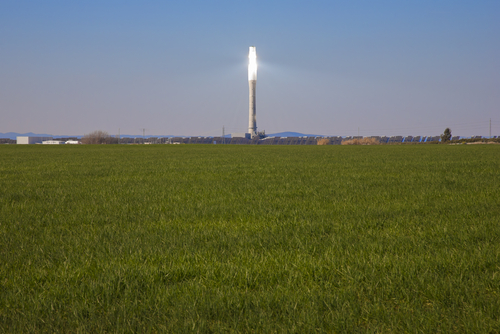For those wanting to understand the effects on grid vitality from renewable energy sources like concentrated solar power, this study from the National Renewable Energy Laboratory (NREL) provides valuable information.

Central tower solar thermal concentration in circular arrangement
CSP with thermal energy storage boosts California electric grid
Researchers from the U.S. Department of Energy’s National Renewable Energy Laboratory (NREL) have quantified the significant value that concentrating solar power (CSP) plants can add to an electric grid.
The NREL researchers evaluated the operational impacts of CSP systems with thermal energy storage within the California electric grid managed by the California Independent System Operator (CAISO). NREL used a commercial production cost model called PLEXOS to help plan system expansion, to evaluate aspects of system reliability, and to estimate fuel cost, emissions, and other operational factors within the CAISO system. The analysis is detailed in a recent publication, Analysis of Concentrating Solar Power with Thermal Energy Storage in a California 33% Renewable Scenario PDF, by Paul Denholm, Yih-Huei Wan, Marissa Hummon, and Mark Mehos.
NREL’s analysis was considered within the context of California’s renewable portfolio standard (RPS), which requires 33% of power be supplied by renewables by 2020. The specific focus was on the “Environmentally Constrained” 33% RPS scenario, which includes a high contribution of generation from photovoltaic solar energy systems. By also considering how the state could take advantage of CSP with thermal storage, NREL used the PLEXOS model to quantify the value of CSP in reducing the need for conventional power generation from fossil fuels, and compared this value to other sources of generation, including photovoltaics, which supply variable energy depending on the amount of sunlight available.
To perform this analysis, NREL Senior Analyst Paul Denholm explains, “We created a baseline scenario, then added four types of generators—a baseload generator with constant output, a photovoltaic system, a CSP plant providing dispatchable energy – or power that can be turned on or off on demand — and another CSP plant providing both energy and operating reserves.”
The analysis demonstrated several valuable properties of dispatchable CSP, such as its ability to generate power during high-value periods when electricity demand is high, and its capability to be turned off during lower-value periods. Of key interest, NREL found that significant operational value is derived when CSP is allowed to provide reserve power, including frequently operating at less than full load, which would be a substantial change in operational practice.
Mark Mehos, manager of NREL’s CSP Program, emphasizes a couple other conclusions from their analysis: “CSP plants switched on during periods of highest consumer demand for electricity resulted in very high capacity value. And the difference in value in CSP plants with and without thermal energy storage depends greatly on the amount of other variable-generation renewable energy sources on the grid, such as wind and photovoltaics.”
Source: AAAS EurekAlert
Photo: CSP tower from Shutterstock
[source: http://feeds.importantmedia.org/~r/IM-greenbuildingelements/~3/YLPq2qDTgOQ/]

Leave a Reply
You must be logged in to post a comment.